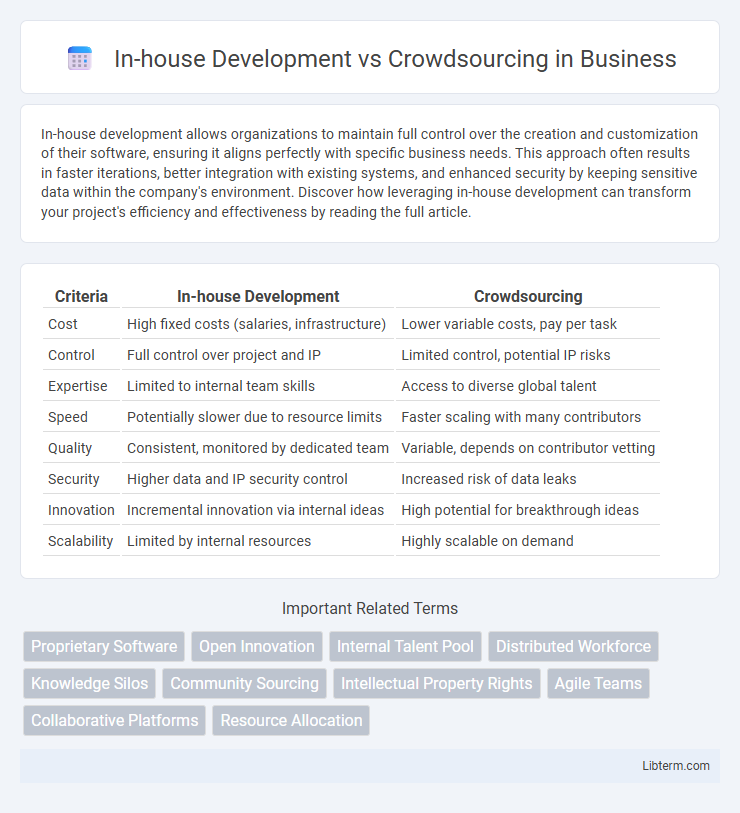In-house development allows organizations to maintain full control over the creation and customization of their software, ensuring it aligns perfectly with specific business needs. This approach often results in faster iterations, better integration with existing systems, and enhanced security by keeping sensitive data within the company's environment. Discover how leveraging in-house development can transform your project's efficiency and effectiveness by reading the full article.
Table of Comparison
| Criteria | In-house Development | Crowdsourcing |
|---|---|---|
| Cost | High fixed costs (salaries, infrastructure) | Lower variable costs, pay per task |
| Control | Full control over project and IP | Limited control, potential IP risks |
| Expertise | Limited to internal team skills | Access to diverse global talent |
| Speed | Potentially slower due to resource limits | Faster scaling with many contributors |
| Quality | Consistent, monitored by dedicated team | Variable, depends on contributor vetting |
| Security | Higher data and IP security control | Increased risk of data leaks |
| Innovation | Incremental innovation via internal ideas | High potential for breakthrough ideas |
| Scalability | Limited by internal resources | Highly scalable on demand |
Introduction to In-house Development and Crowdsourcing
In-house development involves utilizing a company's internal team to design, develop, and implement projects, ensuring direct control over quality, communication, and intellectual property. Crowdsourcing leverages a large, diverse online community to contribute ideas, solutions, or services, enabling access to a broad talent pool and rapid innovation. Both approaches offer distinct advantages in resource allocation, scalability, and project management depending on organizational needs and goals.
Defining In-house Development: Key Characteristics
In-house development involves a dedicated team within an organization responsible for designing, coding, and maintaining software projects, ensuring direct control over quality and timelines. This approach fosters deep organizational knowledge, seamless communication, and alignment with company goals, which can enhance innovation and security. Key characteristics include proprietary resource allocation, ongoing internal support, and full integration with business processes and infrastructure.
Understanding Crowdsourcing in Software Projects
Crowdsourcing in software projects harnesses the collective expertise of diverse contributors globally, accelerating innovation and problem-solving. This method leverages platforms like GitHub and TopCoder to access a wide range of skills, reducing costs and time-to-market compared to traditional in-house development. Effective crowdsourcing requires clear project management, defined contribution guidelines, and robust quality control to ensure successful integration of external inputs.
Cost Comparison: In-house vs Crowdsourcing
In-house development typically entails higher fixed costs due to salaries, benefits, and infrastructure investments, while crowdsourcing offers variable costs aligned with project scope and milestones. Crowdsourcing reduces overhead expenses by leveraging a distributed workforce, often resulting in lower total expenditure for short-term or specialized tasks. However, in-house teams may provide greater long-term cost efficiency through sustained expertise and streamlined communication.
Talent Pool and Expertise
In-house development offers direct access to a dedicated team with specialized expertise tailored to a company's specific needs, ensuring consistent quality and deep organizational knowledge. Crowdsourcing leverages a diverse, global talent pool with varied skills, enabling rapid innovation and access to niche expertise that may not be available internally. Companies must balance the controlled environment of in-house teams against the expansive, flexible resource network provided by crowdsourcing to optimize project outcomes.
Project Management and Workflow Control
In-house development offers project managers direct oversight and real-time control over workflow processes, enabling seamless communication and immediate adjustments to project scope or timelines. Crowdsourcing distributes tasks across a diverse, remote talent pool, which can introduce challenges in maintaining consistent workflow standards and necessitates robust digital tools for effective coordination. Effective project management in crowdsourcing hinges on clear task segmentation, stringent quality control mechanisms, and transparent progress tracking to mitigate risks associated with decentralized workforces.
Quality Assurance and Consistency
In-house development ensures higher quality assurance and consistency by allowing dedicated teams to maintain control over processes and standards throughout the project lifecycle. Crowdsourcing offers scalability but often faces challenges in maintaining uniform quality due to varying skill levels and coordination issues across distributed contributors. Businesses prioritizing reliability and seamless integration benefit from in-house QA practices that foster deep domain knowledge and standardized workflows.
Intellectual Property and Security Concerns
In-house development offers greater control over intellectual property rights and enhances security by limiting access to sensitive data within the organization. Crowdsourcing introduces risks related to IP ownership disputes and potential data breaches due to the involvement of multiple external contributors. Organizations must implement strict contractual agreements and robust security protocols to safeguard proprietary information when leveraging crowdsourcing.
Scalability and Flexibility
In-house development offers limited scalability due to fixed team sizes and resource constraints, making it challenging to quickly ramp up projects. Crowdsourcing provides greater flexibility by tapping into a vast pool of global talent, enabling rapid scaling to meet fluctuating workloads. This approach adapts seamlessly to diverse project requirements while minimizing overhead and resource allocation risks.
Choosing the Right Approach for Your Business
Selecting between in-house development and crowdsourcing depends on factors such as project complexity, budget constraints, and required expertise. In-house development offers greater control, enhanced security, and consistent quality, ideal for long-term projects with proprietary data. Crowdsourcing provides access to diverse talent pools and faster turnaround times, making it suitable for tasks needing quick solutions or specialized skills without significant overhead costs.
In-house Development Infographic

 libterm.com
libterm.com